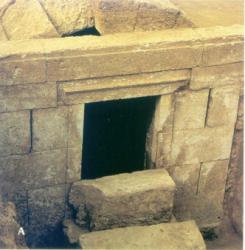INSTITUT SUPERIEUR D'ANTHROPOLOGIE
INSTITUTE OF ANTHROPOLOGY
ONLINE COURSES / COURS A DISTANCE
WINTER TERM : JANUARY 2015
REGISTER NOW
CHINE -  Zhunhua - Eight coffins from Qing Dynasty (1636-1912) imperial figures, including Emperor Qianlong and Empress Dowager Cixi, will be moved to prevent them from decay, said archeologists in north China's Hebei Province. All of the coffins are housed in the imperial family's royal tombs, now named as Eastern Qing Tombs in Zhunhua City, Hebei.,The tombs were looted in 1928 with a large amount of rare treasures, buried as funeral objects, especially from the tombs of Empress Dowager Cixi and Emperor Qianlong, were ransacked. The coffins were split open by the troops of warlord Sun Dianying. The coffins have since been decaying in the tombs, dubbed as the "underground palace", where the environment was humid. "We need to remove the decayed parts and repair them using low nitrogen oxygen technology in order to conserve the coffins for the long term. The Maintenance cost is estimated at 15 million yuan (US$2.4 million) preliminarily," said Wang. The Eastern Qing Tombs consist of 15 mausoleums and 586 individual buildings housing 161 Qing Dynasty imperial family members.
Zhunhua - Eight coffins from Qing Dynasty (1636-1912) imperial figures, including Emperor Qianlong and Empress Dowager Cixi, will be moved to prevent them from decay, said archeologists in north China's Hebei Province. All of the coffins are housed in the imperial family's royal tombs, now named as Eastern Qing Tombs in Zhunhua City, Hebei.,The tombs were looted in 1928 with a large amount of rare treasures, buried as funeral objects, especially from the tombs of Empress Dowager Cixi and Emperor Qianlong, were ransacked. The coffins were split open by the troops of warlord Sun Dianying. The coffins have since been decaying in the tombs, dubbed as the "underground palace", where the environment was humid. "We need to remove the decayed parts and repair them using low nitrogen oxygen technology in order to conserve the coffins for the long term. The Maintenance cost is estimated at 15 million yuan (US$2.4 million) preliminarily," said Wang. The Eastern Qing Tombs consist of 15 mausoleums and 586 individual buildings housing 161 Qing Dynasty imperial family members.
http://www.shanghaidaily.com/national/Emperor-coffins-to-be-rescued-from-Qing-Dynasty-tombs/shdaily.shtml?
IRLANDE –  Galway - Red deer antlers and horse bones dating back 1,500 years from north Galway Bay could have formed part of a ritual ceremony. The antlers, skulls, jaws and bones of the animals were located by Brian O’Carra and Mike Williams on an inter-tidal zone west of Galway city. Cut marks on bones indicate that they were consumed for subsistence or ritually sacrificed, at a time when Christianity was already taking hold in Ireland, Prof Williams says. Eating horses would have been forbidden because of “pagan” connotations, which makes the evidence even more intriguing, he says. Radiocarbon dating of one antler has estimated its age range as being between 430 AD and 548 AD. The finds were in black silty mud containing shells.Only one species of red deer roamed in Ireland at that time, as the fallow deer dates from about 1200 AD. Red deer were important in medieval society, Prof Williams and Mr O’Carra note, and monasteries used them to “establish an identity” for themselves as being beyond royal control. They believe the antlers they found came from young, sexually mature stags. Red deer tend to drop their antlers each year around March and April, after the rutting season. The horse bones matched a small young horse and an older horse or pony. The site appears to have been protected by glacial debris, and remains of drumlins point to a more extensive drumlin field in Galway Bay.
Galway - Red deer antlers and horse bones dating back 1,500 years from north Galway Bay could have formed part of a ritual ceremony. The antlers, skulls, jaws and bones of the animals were located by Brian O’Carra and Mike Williams on an inter-tidal zone west of Galway city. Cut marks on bones indicate that they were consumed for subsistence or ritually sacrificed, at a time when Christianity was already taking hold in Ireland, Prof Williams says. Eating horses would have been forbidden because of “pagan” connotations, which makes the evidence even more intriguing, he says. Radiocarbon dating of one antler has estimated its age range as being between 430 AD and 548 AD. The finds were in black silty mud containing shells.Only one species of red deer roamed in Ireland at that time, as the fallow deer dates from about 1200 AD. Red deer were important in medieval society, Prof Williams and Mr O’Carra note, and monasteries used them to “establish an identity” for themselves as being beyond royal control. They believe the antlers they found came from young, sexually mature stags. Red deer tend to drop their antlers each year around March and April, after the rutting season. The horse bones matched a small young horse and an older horse or pony. The site appears to have been protected by glacial debris, and remains of drumlins point to a more extensive drumlin field in Galway Bay.
http://www.irishtimes.com/news/ireland/irish-news/antlers-and-horse-bones-dating-back-1-500-years-found-on-galway-beach-1.2020780
GRECE –  Pydna - Excavations at the cemeteries of Pydna: two groups: those of the 5th century B.C., when Pydna was the most important port of the Macedonian kingdom as well as its largest urban center and those of the Late Classic period until the middle of the 2nd century B.C., during the time of the great expansion of the Macedonian kingdom with Philip B initially, the time of Alexander the Great and finally the decline of the kingdom and its reformation to the first province of Rome in the East in 148 B.C. The tombs of the 5th century B.C. are mainly located in the north of the fortified town of Pydna next to two ancient roads and are very densely organized. After the middle and until the end of the 4th century Β.C. there is a large expansion of the Pydna cemeteries and an even greater variety of burial structures and practices. During this period, there is a gradual tendency towards monumental constructions and the distinction in the orientation of the graves is now more common. By the end of the 4th century B.C. a definite tendency towards more standard construction is found in the cemeteries of Northern Pieria.Τhe standardization of tombs evolves even more in the 3rd century B.C. till the beginning of the 2nd century B.C., but varies in the years close to the battle of Pydna (168 B.C).
Pydna - Excavations at the cemeteries of Pydna: two groups: those of the 5th century B.C., when Pydna was the most important port of the Macedonian kingdom as well as its largest urban center and those of the Late Classic period until the middle of the 2nd century B.C., during the time of the great expansion of the Macedonian kingdom with Philip B initially, the time of Alexander the Great and finally the decline of the kingdom and its reformation to the first province of Rome in the East in 148 B.C. The tombs of the 5th century B.C. are mainly located in the north of the fortified town of Pydna next to two ancient roads and are very densely organized. After the middle and until the end of the 4th century Β.C. there is a large expansion of the Pydna cemeteries and an even greater variety of burial structures and practices. During this period, there is a gradual tendency towards monumental constructions and the distinction in the orientation of the graves is now more common. By the end of the 4th century B.C. a definite tendency towards more standard construction is found in the cemeteries of Northern Pieria.Τhe standardization of tombs evolves even more in the 3rd century B.C. till the beginning of the 2nd century B.C., but varies in the years close to the battle of Pydna (168 B.C).
http://www.archaeology.wiki/blog/2014/12/02/excavations-cemeteries-ancient-pydna/